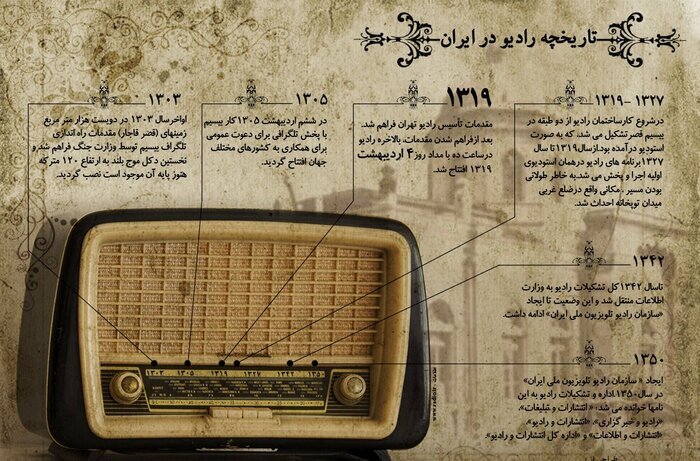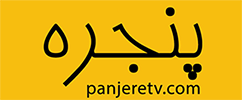Iran’s first Radio transmitter station was opened on May 6, 1305 at three o’clock in the afternoon with a telegraphic broadcast for the public invitation to cooperate with different countries of the world [1] and the message that was transmitted from Iran station was to the effect that “at this time, It is the opening ceremony of this station. From today, this telegraph device is proud to invite related devices to communicate with it”.

Therefore, the establishment of this wireless was an important step in the establishment of radio. With the expansion of its activities, a group of wireless employees was sent to France for specialized training, and about 11 years after that in 1316, the Minister of Posts and Telegraphs at that time bought three short and medium-wave radio transmitters. And with the construction of the necessary buildings for this, the cornerstone of the idea of creating radio in Iran was laid.
Radio Tehran
Radio Tehran was officially opened on May 5th 1319 solar. [4] In this opening, Matin Dafari said in his speech: The radio was created as an educational device to cultivate thoughts in various fields of knowledge and it will convey its information to the listeners immediately and without delay, and thanks to this gift of our compatriots They should always try to increase their knowledge and apply it for the advancement of the country”.
In the year of its opening, Radio Tehran had a medium wave transmitter with a power of 2 kW, a short wave transmitter with a power of 14 kW, a power generator, and a sound transmission device. The responsibility of advertising department, which was established in Mehr 1319, was under the responsibility of Dr. Isa Sediq until September 1320, and then Dawood Pirnia, who graduated from the mathematics department of the university and was an active, serious, and people-oriented youth, was appointed as the head of this department. Then they rented a renovated house in the land around Mashakh Square in the western part of the Rahni Bank building, and thus, for the first time in Iran, such an office was established to manage the government radio transmitter.
According to Dr. Issa Sediq, the name of the Publicity Department was changed to the Information and Radio Department from Shahrivar 1319, and its establishment was like this: “After providing a suitable place for the administration and providing furniture and hiring the necessary members for clerical and administrative affairs and transferring the correspondence department From the Ministry of Interior and Pars News Agency from the Ministry of Foreign Affairs and Radio from the Ministry of Posts and Telegraphs, I tried to determine the basic goal, policy and work program of the General Directorate of Publications and Advertising. In order to use the opinion of the country’s scientists, according to my proposal and the approval of the government, the Supreme Council of Publications was formed by the following people: Zaka-ul-Molk Foroughi, Mohammad Qazvini, Dr. Qasim Ghani, Dr. Siasi, Dr. Mohammad Afshar, Dr. Shafaq, Ali Naghi Waziri.
Radio programs
In those years, there was no electricity in Tehran 24 hours a day, so radio programs were limited to certain hours. Thus, Iran Radio, which was opened in May 1319, had only 2 programs a day. The first part: was from 12:00 to 13:30, and the second part was from 18:00 to 22:30. In the first and second parts, four speeches were read every day and each speech was for 15 minutes, then some Iranian and western music was played.??? The radio broadcasted every day from 4 pm to midnight. The first radio program was broadcast live for eight hours and in addition to Persian programs, it included the news in French, English, German, Arabic, Turkish and Russian languages. At the beginning of 1322, there were changes in the program of Radio Tehran and the radio was able to broadcast programs for 2 hours in the morning. The preparations for radio programs started gradually with the formation of five internal commissions, i.e. 1) Speech and Oratory Commission, 2) Drama Commission, 3) Press Commission, 4) Radio Speech Commission, and 5) Music Commission.
In the beginning, the preparation of radio news was done by the Pars news agency and government ministries and organizations. In this way, the prime minister, through a circular, had obliged all the ministries and governorates to send the beneficial and public benefit measures of their mission to the radio in a pleasing and suitable manner. Sometime later, the political and social articles of the center’s newspapers were also included in the list of radio programs, but the summaries of these articles were monitored before broadcasting and broadcast after permission was issued. Iranian news was also translated into foreign languages and then broadcast. For this purpose, a permanent committee composed of Mr. Hijazi, Dr. Shafaq, and Saeed Nafisi was formed in the radio office, which checked the news and speeches that had to be translated and broadcast in foreign languages every day, and after the necessary corrections, immediately sent to the office. The radio was returned.
Radio and World War II
The military occupation of Iran by the Allies in Shahrivar 1320 was a major obstacle to the expansion of the radio network in Iran and kept this institution stagnant for some time. The fledgling organization of Iran Radio was still in the early stages of its development, but unfortunately, due to the spread of World War II and the dangerous ways of transporting goods, machinery, and spare parts, they did not arrive on time, and naturally, they had become rare and more expensive, and these problems hindered Radio Iran was expanding rapidly.
The Allies were trying to bring the public opinion of Iranians, who did not have good memories of these two governments due to the colonial background of the Russian and British governments, and were optimistic about the Germans beyond their behavior as enemies of these governments, or at least from Prevent its destructive action. On this basis, they wanted to publish news from radio and newspapers that would be good for their war policy. Thus, the Allies, as defenders of the free world, went to battle with fascism and Nazism with the weapon of censorship.
Finally, following the pressure of the British political representative, the Iranian government was forced to give in to the creation of a censorship circle to control press and radio news. The Censorship Circle was formed in March 1320 with the presence of representatives of the Soviet and British governments along with the representative of the General Directorate of Publications and Advertising. At that time, radios were mostly in cars and public places. Therefore, in a letter dated April 11, 1321, Serrider Bullard, the British Ambassador to Iran, requested the Iranian Prime Minister to collect the radios of cars and buses. When the government informed the British ambassador about the lack of radios in rental cars and buses, Ambassador Samaj insisted on collecting radio devices from private cars. This request was raised in the cabinet and it was decided to write to the police department to remove the car radios. The British were so determined in this matter that regardless of the existence of the Iranian government, they personally inspected and spied on the cars of the radio owners and asked the Iranian authorities to confiscate their radios as soon as possible.
Radio in the cities
After Radio Tehran, due to the strengthening of 250 and 350-kilowatt short wave transmitters in Kamal Abad, Tehran, for city centers, Tabriz radio transmitter started working in 1326, and gradually in cities such as Mashhad, Rezaiyeh, Ahvaz, Kermanshah, Shiraz, Isfahan, Kerman, Sanandaj, Zahedan, Rasht, Gorgan, Ilam, Sari, Mahabad, Khorramabad, Bandar Abbas, Yazd, Khash, Zabul, Bushehr, Yasouj, Lawan, Shahrekord, Zanjan, Jolfa, Baneh, Middle, Birjand, Bojnord, Radio transmitters were also installed in Chalus, Radio Darya and Parsabad Moghan. All in all, 355 million rials were allocated for the purchase and installation of new transmitters and their devices in the third program. All the new transmitter stations that were purchased to broadcast the sound of Radio Iran were installed in Kamal Abad between Qazvin and Karaj, about 50 km from Tehran.
